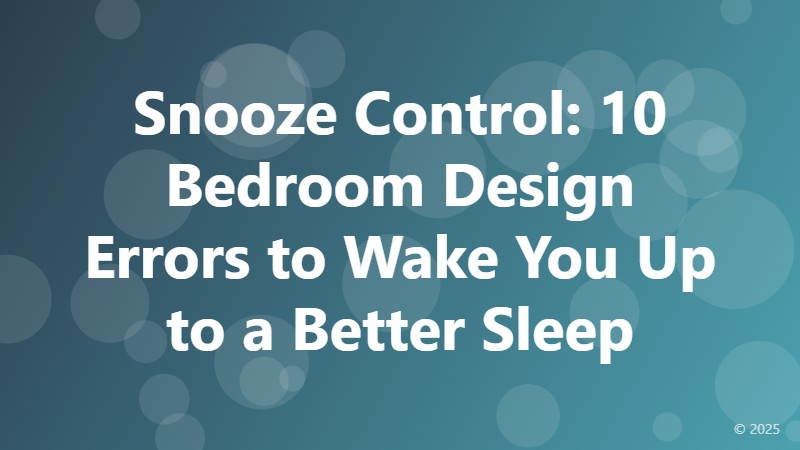Snooze Control: 10 Bedroom Design Errors to Wake You Up to a Better Sleep

When it comes to designing a bedroom, it's easy to get caught up in the excitement of picking out furniture and decor. However, a well-designed bedroom is more than just aesthetically pleasing – it's also functional and conducive to a good night's sleep. Unfortunately, many of us make common bedroom design errors that can disrupt our sleep patterns and leave us feeling groggy and unrefreshed. In this article, we'll explore the top 10 bedroom design mistakes to avoid, so you can wake up to a better sleep.
1. Insufficient Natural Light
Natural light is essential for regulating our circadian rhythms, but many bedrooms lack sufficient natural light. This can lead to difficulty falling asleep, insomnia, and other sleep-related problems. To avoid this error, consider installing skylights or larger windows, and keep curtains and blinds open during the day to let the sunlight in.
2. Inadequate Storage
A cluttered bedroom can be overwhelming and stressful, making it difficult to wind down at night. Insufficient storage can lead to clutter, so make sure to invest in a bed with built-in storage, use baskets and bins to store clothing and accessories, and keep surfaces clear of clutter.
3. Poor Color Choices
The colors you choose for your bedroom can greatly impact your sleep. Avoid bright, bold colors that can stimulate your brain and make it difficult to fall asleep. Instead, opt for calming colors like blue, green, and neutral tones that can promote relaxation.
4. Inadequate Soundproofing
Noise can be a significant disruptor of sleep, so it's essential to soundproof your bedroom. Consider adding area rugs, using acoustic panels, and installing soundproofing windows to create a peaceful environment.
5. Incorrect Bed Placement
The placement of your bed can greatly impact your sleep. Avoid placing your bed under a window, opposite a door, or in a corner, as this can create a sense of unease and discomfort. Instead, place your bed in a commanding position, where you can see the door but are not directly in line with it.
6. Lack of Texture
A bedroom without texture can feel cold and uninviting. Add texture to your bedroom through throw blankets, rugs, and upholstered furniture to create a cozy and inviting atmosphere.
7. Inadequate Lighting
Lighting can greatly impact our mood and sleep patterns. Avoid harsh overhead lighting and instead opt for table lamps, floor lamps, or string lights that can create a warm and inviting atmosphere.
8. Ignoring Feng Shui
Feng shui is the ancient practice of arranging your environment to promote harmony and balance. By ignoring feng shui principles, you can create a bedroom that feels unbalanced and stressful. Consider consulting with a feng shui expert or doing some research to learn how to apply feng shui principles to your bedroom design.
9. Not Considering Technology
Technology can be a significant disruptor of sleep, so it's essential to consider how you'll use technology in your bedroom. Avoid placing TVs and computers in the bedroom, and use blue light filtering glasses or apps to reduce the impact of screens on your sleep.
10. Not Creating a Calming Atmosphere
A bedroom should be a calming and relaxing environment, but many of us fail to create this atmosphere. Avoid using bright colors, bold patterns, and loud decor, and instead opt for calming elements like plants, candles, and soft music to create a peaceful atmosphere.
By avoiding these common bedroom design errors, you can create a bedroom that promotes relaxation, reduces stress, and improves the quality of your sleep. Remember, a well-designed bedroom is not just aesthetically pleasing – it's also essential for a good night's sleep.